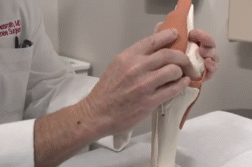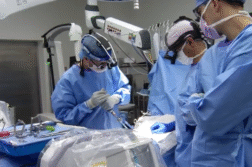JACKSONVILLE, Fla. (Ivanhoe Newswire) – Studies show that one third of men and women in the U.S. have a bunion — that painful bone that sticks out of your foot. It can cause excruciating pain and literally knock you right off your feet. They’re mostly caused by genetics, but wearing tight shoes can aggravate bunion symptoms. Four hundred thousand people a year will have surgery to try and relieve their pain. Now, a new procedure is offering hope to get rid of them once and for all.
Marathons, ultra-marathons, triathlons, iron man – Paul Wilson finds his joy in running.
“The longest run I’ve ever done solo is the 55 miles,” he says.
Paul even turned his passion into a mission – when his newborn son underwent lifesaving surgery, he created an annual ultra-marathon run to raise money for the hospital that saved his son’s life. But Paul was sidelined by severe pain in his left foot caused by a bunion.
Hiram Carrasquillo, MD, orthopedic surgeon at Jacksonville Orthopaedics Institute explains, “Normally, what you see in a bunion is some instability that comes from the midfoot part and then it allows that bone to go out, creating the boney prominence on the side.”
Traditional surgery requires the bone on the side of the toe to be shaved off. Recovery can be long and painful, and there’s a 70 percent chance of recurrence. Now, Dr. Carrasquillo is using a new FDA-cleared Lapiplasty 3D bunion correction procedure to get to the root of the problem.
“It’s three dimensional. When you correct this, you rotate, bring it in, and bring it down at the same time,” Dr. Carrasquillo adds.
Six weeks after surgery, Paul was wearing shoes, and this year, he ran in the race he started.
Paul proudly says, “It’s about getting back to what I truly love doing.”
The Lapiplasty procedure has also shown a low recurrence rate. Studies show up to 99 percent of patients do not have a recurrence of the bunion 17 months after the surgery. Lapiplasty 3D bunion correction is generally covered by most insurances and Medicare.
Contributors to this news report include: Marsha Lewis, Producer; Matt Goldschmidt, Videographer; Roque Correa, Editor.
To receive a free weekly e-mail on medical breakthroughs from Ivanhoe, sign up at: http://www.ivanhoe.com/ftk
Source:
MEDICAL BREAKTHROUGHS
RESEARCH SUMMARY
TOPIC: STEP INTO COMFORT: BREAKTHROUGH BUNION PROCEDURE
REPORT: MB #5378
BACKGROUND: Bunions are a common foot condition in the United States, affecting millions of individuals across all age groups. A bunion is a bony bump that forms at the base of the big toe, causing it to push against the adjacent toe. They can result in pain, swelling, redness, and difficulty walking or wearing shoes comfortably. The exact cause of bunions is not always clear, but they are often attributed to a combination of genetic predisposition and environmental factors. Certain foot shapes and inherited structural abnormalities can increase the likelihood of developing bunions. In contrast, factors such as wearing tight or narrow shoes, high heels, or engaging in activities that put excessive pressure on the feet can exacerbate the condition. In the United States, bunions are more prevalent among women than men, with studies suggesting that up to 30 percent of women may develop bunions at some point in their lives. This is partly due to the types of shoes typically worn by women, such as high heels and narrow-toed shoes, which can increase the risk of developing bunions by forcing the toes into unnatural positions. Bunions can have a significant impact on quality of life, causing discomfort and limiting mobility.
DIAGNOSING: Diagnosing bunions typically involves a combination of medical history, physical examination, and sometimes imaging studies. The doctor will begin by asking about the patient’s symptoms, including when they first noticed the bunion, any pain or discomfort associated with it, and any factors that exacerbate or alleviate the symptoms. The doctor will visually inspect the foot for signs of a bunion, such as a visible bony bump at the base of the big toe and deviation of the big toe toward the other toes. In some cases, the doctor may use a device called a goniometer to measure the angle of the bunion deformity and assess its severity. X-rays may be ordered to confirm the diagnosis of a bunion and assess the extent of the deformity. In some cases, other conditions may mimic the symptoms of a bunion, such as arthritis, gout, or inflammation of the sesamoid bones beneath the big toe joint. Treatment may range from conservative measures such as wearing wider shoes, using orthotic inserts, and applying ice packs to reduce inflammation, to more invasive options such as corticosteroid injections or surgery in severe cases.
(Sources: https://nyulangone.org/conditions/bunions/diagnosis
https://my.clevelandclinic.org/health/diseases/14386-bunions-hallux-valgus)
NEW TECHNOLOGY: A new procedure known as Lapiplastry is a new breakthrough in bunion surgery. The technique uses patented technology to correct the bunion and its root cause. It works by straightening three dimensions of alignment to the metatarsal bone and corrects the sideways lean of it.
FOR MORE INFORMATION ON THIS REPORT, PLEASE CONTACT:
Kaitlin Gallagher
If this story or any other Ivanhoe story has impacted your life or prompted you or someone you know to seek or change treatments, please let us know by contacting Marjorie Bekaert Thomas at mthomas@ivanhoe.com




